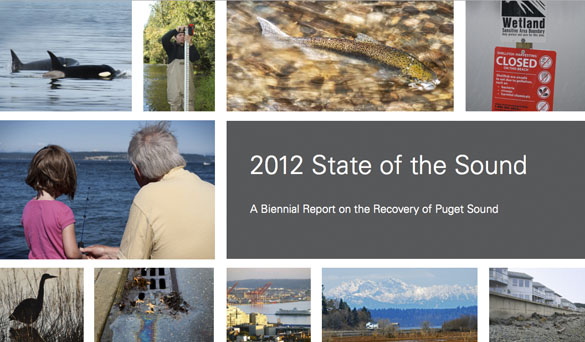The Puget Sound Partnership’s 2012 State of the Sound report, released Nov. 1 to the Governor’s Office, shows that the region has slowed the decline in the health of Puget Sound and increased the number of healthy shellfish beds and restored estuaries. But the region is still losing ground in many areas.
“The impacts of the last 100 years have taken their toll — they are not undone overnight,” said Martha Kongsgaard, Chair of the Partnership’s Leadership Council. “However, our regional efforts have reversed the decline that would likely have continued without our concerted and deliberate intervention.”
The 2012 State of the Sound report shows improvements in two Vital Signs between 2007 and 2011: nearly 1,400 acres of shellfish beds were reopened for harvest; and approximately 2,300 acres of habitat restoration projects were completed in the 16 major river delta estuaries.
“The increase in healthy shellfish beds and restored habitat are both areas where we have seen major collaborative efforts. For example, recent shellfish bed upgrades in Oakland Bay are the work of government, tribes and business working together,” said Anthony Wright, executive director of the Puget Sound Partnership. “What this report shows us is that we see progress when we work together as a region. When we coordinate funding and efforts on big picture projects, Puget Sound wins.”
Progress in the region has not been sufficient to meet 2020 ecosystem recovery targets for the region.
“We must redouble our efforts to fund this critical work,” said Wright. “The cost seems significant when contrasted with competing needs in our state, but pales in comparison to the benefits we derive from Puget Sound, and that cost we pass on to our children if we wait.”
The State of the Sound is a required report meant to reflect the current status of the Puget Sound ecosystem and of regional implementation and funding. The purpose of this information is to inform decisions about changes needed to funding, programs or policies that might accelerate the progress to restore Puget Sound, including more efficient use of resources. The report reflects work by citizens, governments, tribes, nonprofits, communities, scientists and businesses throughout the region.
Highlights of the State of the Sound report include a summary of progress towards 2020 targets based on the 21 vital signs; a quick peek at the progress to save Puget Sound; individual reports on the Vital Signs; things that partners have done to achieve ecosystem recovery; and barriers to restoring Puget Sound.
More information on the 2012 State of the Sound report is available online at psp.wa.gov/sos.php.
The Puget Sound Partnership is a state agency that coordinates the efforts of citizens, governments, tribes, scientists, nonprofits and businesses to set priorities, implement a regional recovery plan and ensure accountability for results leading the recovery of Puget Sound. More information is available online at psp.wa.gov.






